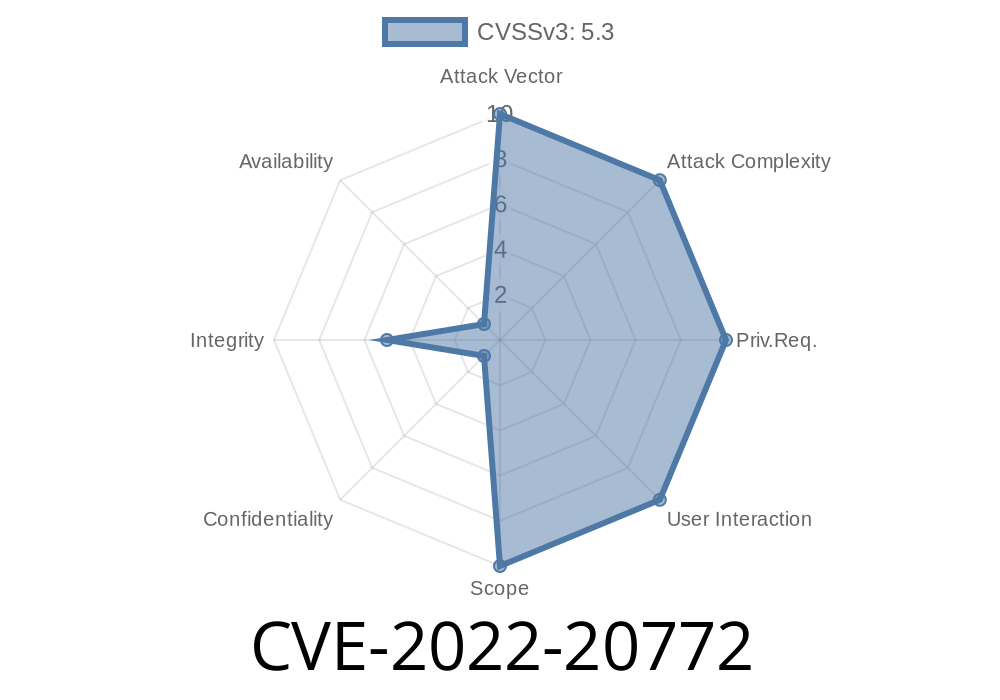A recently disclosed vulnerability (CVE-2022-20772) has been identified in the Cisco Email Security Appliance (ESA) and Cisco Secure Email and Web Manager (SMA) that could allow an unauthenticated, remote attacker to conduct an HTTP response splitting attack. This could potentially lead to the disclosure of sensitive information, session hijacking, or alteration of the target application's functionality.
This article will delve into the specifics of the vulnerability, including the impacted products, exploitation techniques, and possible mitigation strategies. We will also provide code snippets to help you better understand the vulnerability and reproduce its impact in a controlled environment.
Vulnerability Details
The vulnerability, classified as CVE-2022-20772, is due to the failure of the impacted applications or their environment to properly sanitize input values. As a result, an attacker could exploit the vulnerability by injecting malicious HTTP headers, controlling the response body, dividing the response into multiple responses, thereby conducting an HTTP response splitting attack.
Exploitation Techniques
An attacker could exploit the vulnerability by sending a crafted HTTP request to the target application. The following code snippet demonstrates a sample HTTP request that contains malicious headers:
GET /vulnerable-path?parameter=value%D%AInjected-Header:%20Malicious HTTP/1.1
Host: target.example.com
Accept: */*
User-Agent: ExampleUserAgent
...
In this example, %D%A represents a newline (Carriage Return and Line Feed - CRLF), which allows the attacker to inject a new HTTP header called Injected-Header with a malicious value. The attacker could then control the response body or split it into multiple responses.
Mitigation Strategies
Cisco has released software updates that address the vulnerability. Administrators should apply these updates to the affected systems as soon as possible. The fixes can be downloaded from Cisco's Download Software portal (https://software.cisco.com/download/home). Detailed instructions on how to apply the updates are available in the official security advisory (https://tools.cisco.com/security/center/content/CiscoSecurityAdvisory/cisco-sa-esa-sma-http-inj-cVEwHkzf).
In addition to applying the provided updates, consider the following best practices to reduce the risk of similar vulnerabilities:
1. Input Validation: Perform strict input validation and sanitization to prevent attackers from injecting malicious data into input fields.
2. Output Encoding: Implement proper output encoding to prevent attackers from modifying the HTTP response.
3. Secure Headers: Utilize security headers like X-Content-Type-Options, X-Frame-Options, and X-XSS-Protection to further reduce the risk of exploitation.
4. Regularly Monitor and Patch: Routinely monitor security advisories and apply patches as soon as they become available.
5. Employee Training: Provide security awareness training to employees to foster a culture of security and prevent social engineering attempts that could lead to the disclosure of sensitive information or system access.
Conclusion
The CVE-2022-20772 vulnerability in the Cisco Email Security Appliance (ESA) and Cisco Secure Email and Web Manager (SMA) could allow unauthenticated, remote attackers to conduct HTTP response splitting attacks. Administrators should apply the recommended software updates immediately and follow security best practices to mitigate the risk of similar vulnerabilities in the future. By understanding the technical aspects of the vulnerability, you can better protect your organization and maintain a safer digital environment.
Timeline
Published on: 11/04/2022 18:15:00 UTC
Last modified on: 11/08/2022 15:00:00 UTC
